9 Shakespeare Paintings by John Everett Millais
Back in 1590, when Henry IV first appeared on stage, Shakespeare could not have foreseen the popularity of his creations. The appeal of characters...
Ledys Chemin, 23 April 2024
As an art form, Thai dance has been honed over many centuries. It is one of the great wonders of the human imagination. We can enter a theater, enjoy a dance performance, and quickly set aside the worries of everyday life. For a time, we can become involved in characters as they struggle with their problems. For a time, their problems are ours. As they resolve their struggles, we return to our more mundane affairs, refreshed, and better able to deal with our own cares.
There are over a hundred different dance traditions in Thailand. However, Thai classical dance includes only several forms, and the Khon or masked drama is one of the most refined of them. It is a combination of dance, elaborate costumes, singing, speaking, and music. Initially, the Khon was performed at the royal court. It was based on the tales of the Ramakien or the Glory of Rama, which is an adaptation of the Ramayana, the Indian Hindu epic.
Throughout many centuries, Thai people revered their rules. In 1782, when a king of the new Chakri Dynasty ascended the throne, he took the title Rama the First (1737–1809). It comes from the name of the Hindu deity Rama, the seventh avatar of the God Vishnu. All subsequent kings used this kind of title and the current king of Thailand is Rama the Tenth.
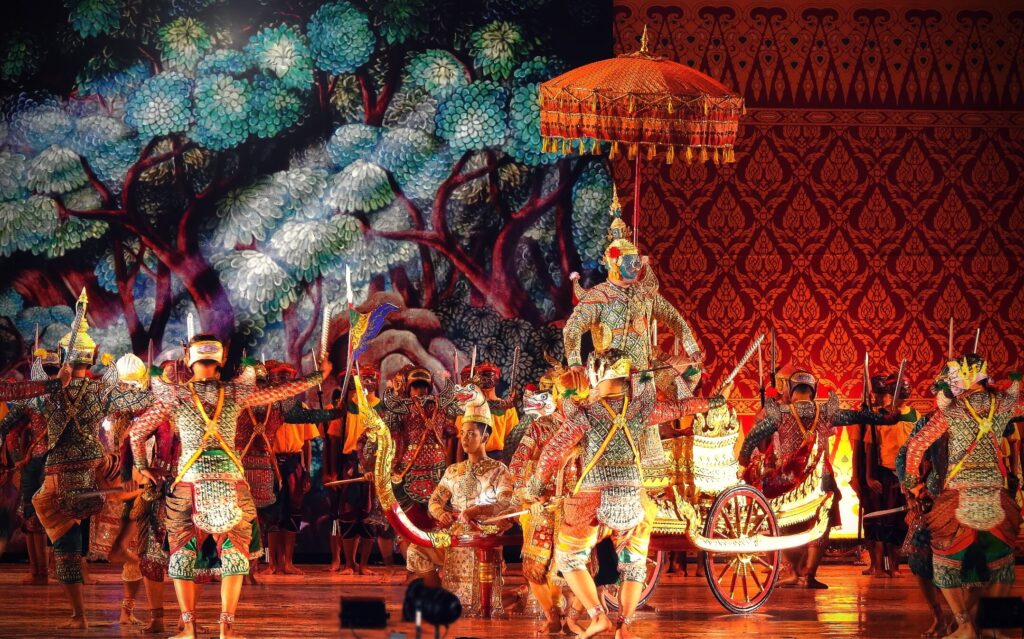
It was not a coincidence that the first Chakri King decided to revive the dancing and performing of the Ramayana. In the center of this great epic is Rama, a deity and an ideal king with many loyal subjects. He always prevails in the struggle against evil. Thus, the development of this dance form could serve social, cultural, and political purposes.
In 1783, Rama I ordered the construction of the Grand Palace in the center of Bangkok. There are a number of buildings within its premises, such as Wat Phra Kaew or the temple of the Emerald Buddha. It is regarded as the most sacred Buddhist temple in Thailand. The inside of the wall contains 178 murals painted in the early 19th century illustrating the Ramakien.
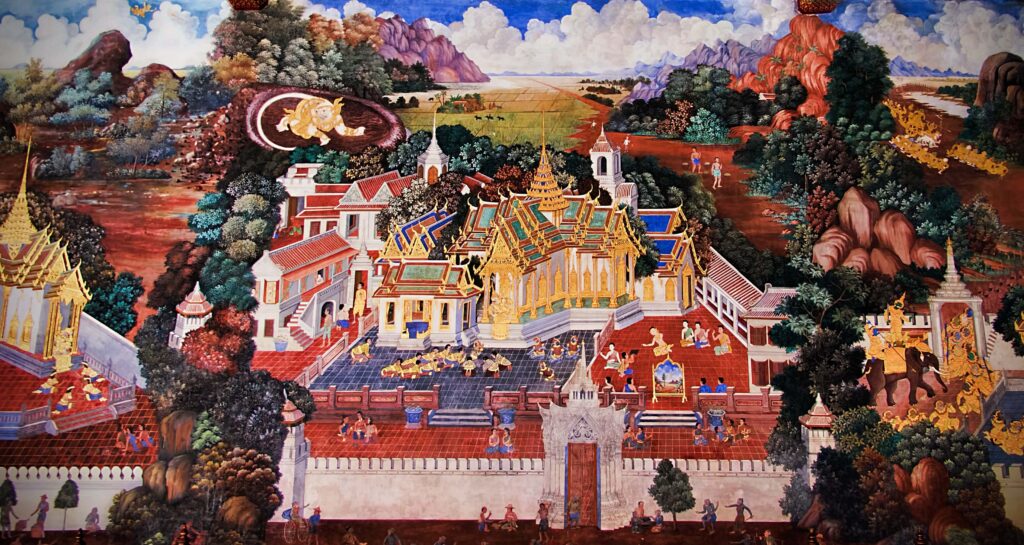
In the Indian version of the tale, Rama is the prince of the Kosala Kingdom. His stepmother, Kaikeyi, resorts to tricks so that her son, Bharat, could take the throne. As a result, King Dasharatha sends his son Rama on a fourteen-year exile. Rama travels across forests with his wife Sita and brother, Lakshmana. When Ravana, the king of Lanka, kidnaps Sita, a war ensues. The monkey army led by Hanuman and other of Rama’s followers helps him to defeat Ravana and his retinue of demons. Eventually, Rama returns to his birthplace, Ayodhya, where he becomes the king.
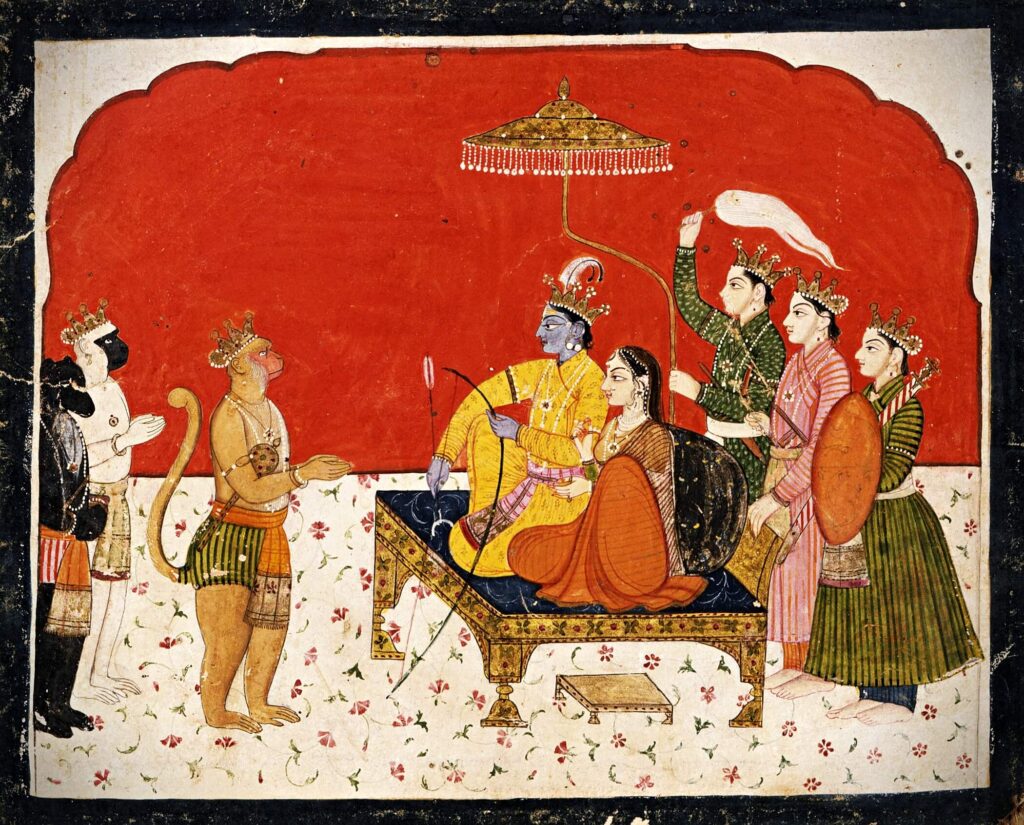
In Thailand, Ramayana was adapted to the local culture. Some names of the heroes and settings were changed. For example, Rama became Phra Ram and Ravana turned into the demon king Tosakanth. Still, in the Ramakien, the unpredictability of life was portrayed in easily recognizable terms.
Furthermore, a few kings attempted to create their own version of the Ramakien. For example, King Rama I’s version is the complete one, while that of King Rama II (1767–1824) is the most famous for its beautiful poetical rhymes and rhythms. They have written additional episodes and included more characters. Thus, the Thai version has become longer and more complicated than the Indian Ramayana.
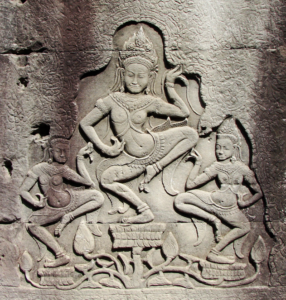
Thai classical dance may have come from the Khmer tradition. For example, we find the dance images in the Khmer reliefs of the Bayon temple in Angkor, Cambodia. The Khmer-related reliefs also appear in the Phimai temple in eastern Thailand. Alternatively, Brahman gurus from India could have brought the dance tradition to the country.
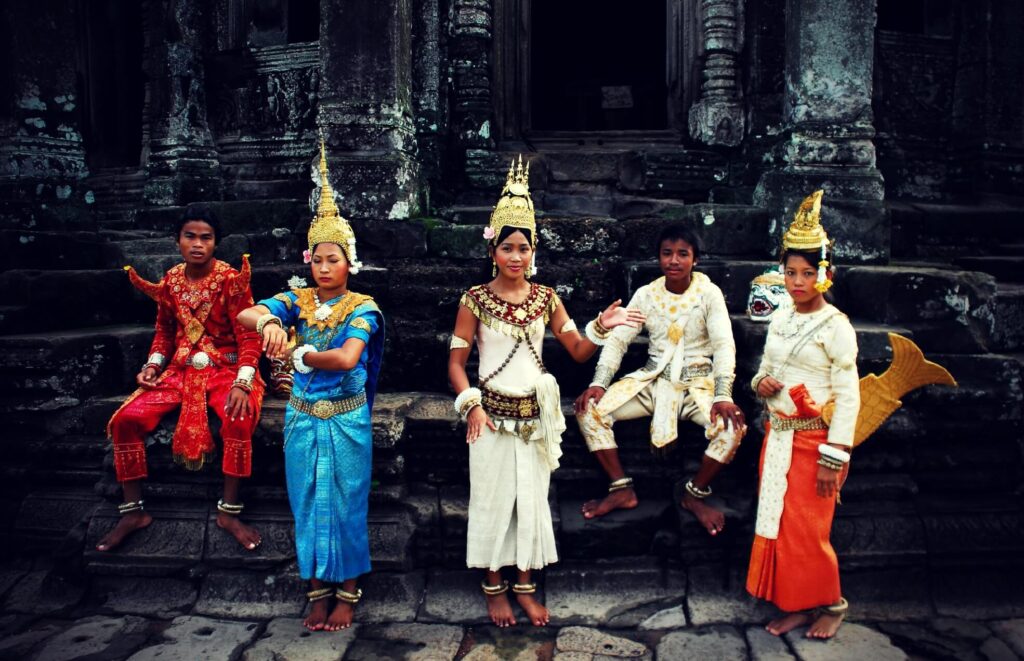
However, Thai dance differs from Khmer or Indian traditions. It emphasizes the movements of the arms, hands, and fingers. One of the characteristics of the Khon is that some dancers wear masks. The actors perform two kinds of dancing. The first one is tent and uses mostly legs, while the other is rum and engages arms in a very slow manner.
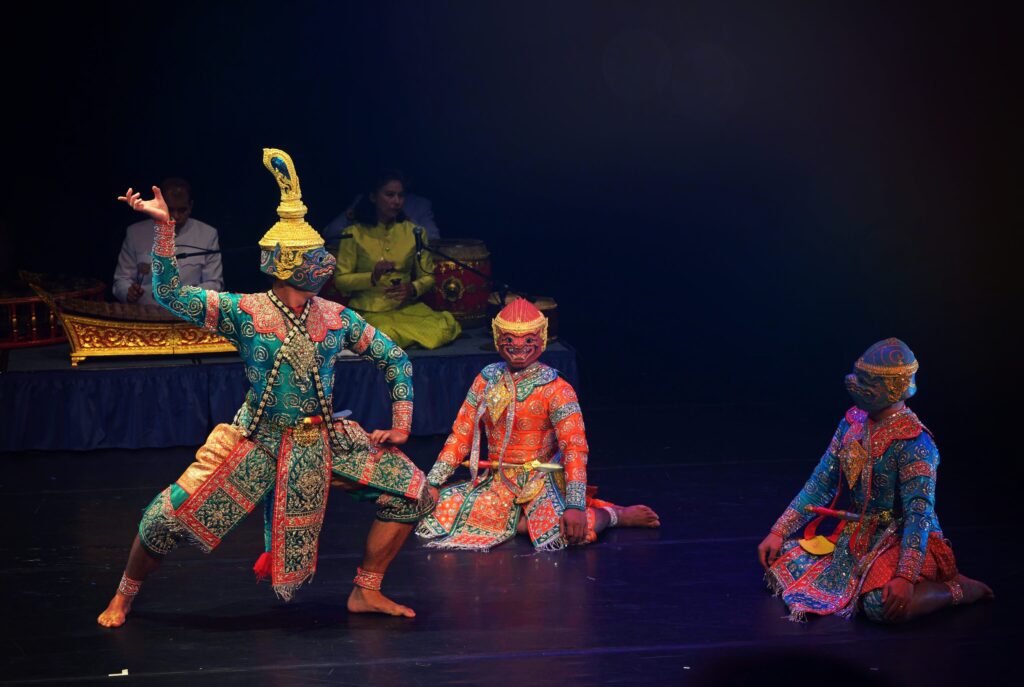
The Khon play may have combined various art forms, such as the ancient chak nak, the grand shadow play, and the fighting techniques from the Thai classical martial art called krabee krabong. The use of masks, dresses, and headdresses were probably derived from the chak nak.
The traditional Milk Ocean Stirring Ceremony as a part of the coronation celebration activities of Thai kings has also shaped the Khon dance. It is an open-air performance with dancers dressing up and wearing masks personifying demons and angels. This dance aims to glorify the new king and ensure the people’s loyalty to the monarch. The performances are also a part of social practices such as royal cremation, the cremation of a high-ranking person or revered monks, the celebration of sacred sites, birthdays, and the opening of new businesses.
The Khon actors and dancers are unable to utter any sound because of the masks they have to wear on stage. Therefore, the singers and narrators sit with the orchestra at the side of the stage. By speaking and singing, they provide a major element of the Khon performance and control the whole show. Learning the words and the music takes a lot of hard work and talent. Singers memorize words usually by listening to their teachers, who have, in turn, heard it from their own teachers.
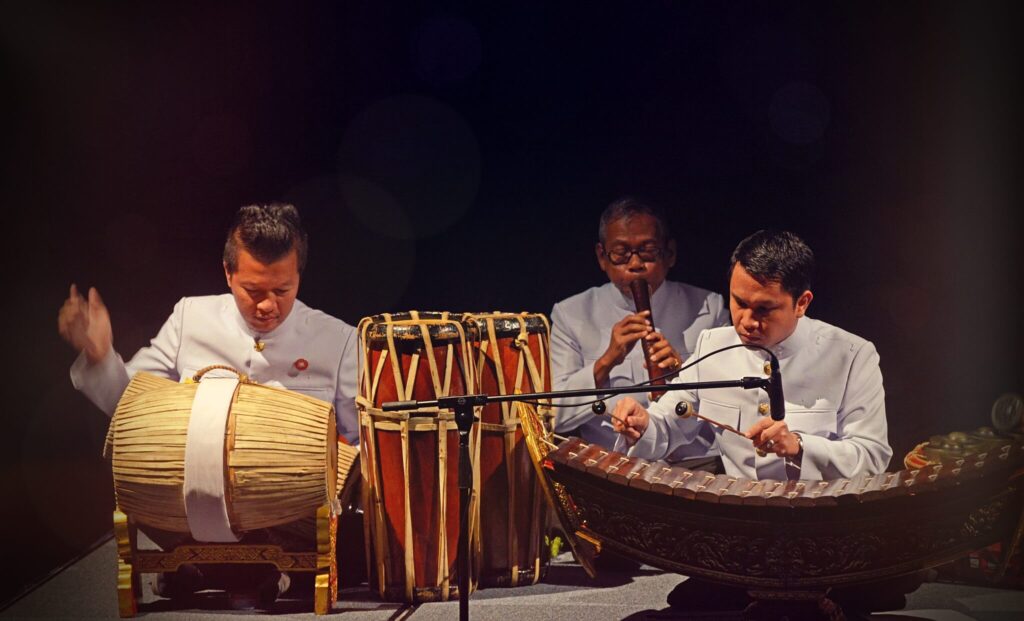
Furthermore, the music, accompanying the dance, is a folk-based music. It has melody only and usually without bass or inner lines of music. Wind, hammered, and stringed instruments enliven the performance. They are accompanied by a medley of drums and percussions. For example, pi glarng is a type of Thai flute, while tapon is a two-faced yellowish drum, and klong tudd is a reddish double-headed drum. This kind of orchestra is known as a piphat. The actors fit their performance to the words of the singers. The language of the dancers is the language of gesture and movement.
Generally, the performance of the Khon dance is composed of various kinds of characters, such as demons, monkeys, heroes, and heroines. All of the Khon characters have different manners and costumes. The characters of the Ramakien fall into three main groups.
The first group is the heroes and heroines, who do not wear masks. They can be refined human beings, gods, or goddesses. In appearance, these forces of good are usually handsome and noble. The main heroine keeps her real emotions hidden, no matter what she is really feeling. For example, when she is sad, she will not cry out. She will give only a polite smile to show that she is happy. Moreover, she will not stamp her feet when she is angry. To show her anger, she will give only a small sign of annoyance.
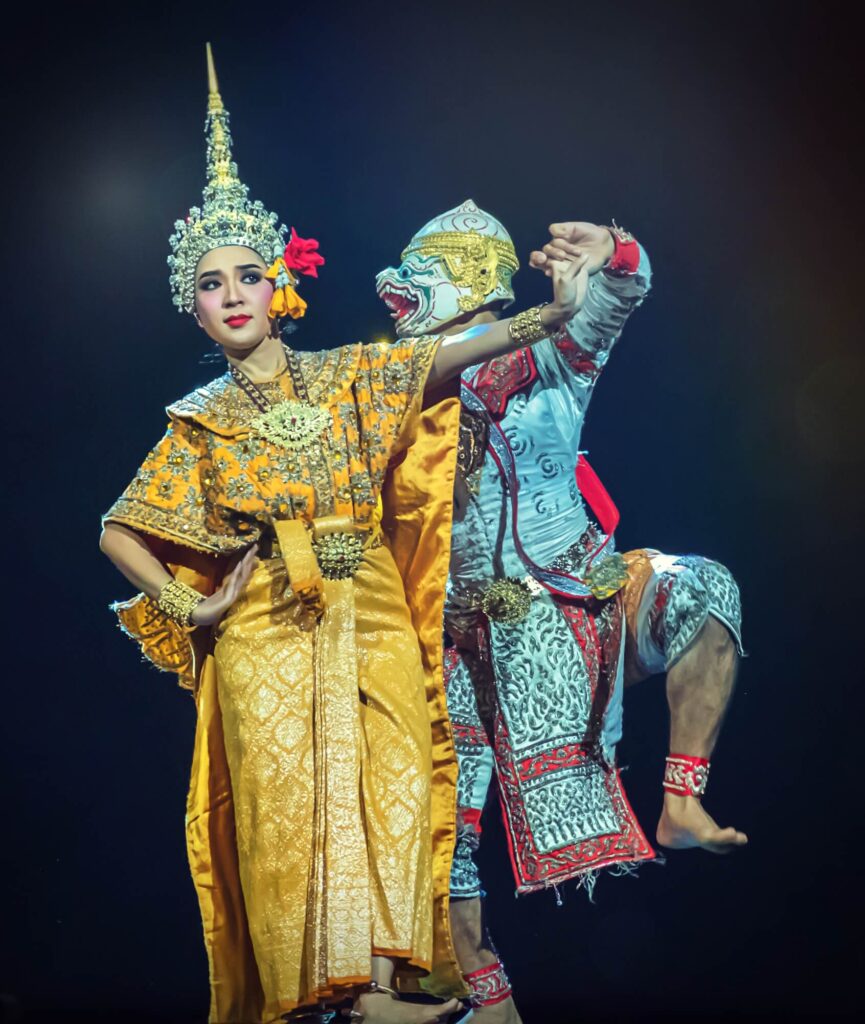
Echoing the Indian mudras, the dance of heroes and heroines makes use of meaningful and elegant hand gestures. The steps are light. The bare soles of the feet rarely touch the ground, and the toes are often turned upwards. In India and in most Southeast Asian traditions, bare footedness is a ritual feature. The stage and the actual performance are regarded as sacred.
The second group is the demons, the enemies of heroes. The world is beset by people who try to take over or dominate human society, from time to time. The idea that all human beings might live together in harmony and cooperation does not suit someone who wants power and possessions all for himself. Therefore, there are plenty of bullying demons around.
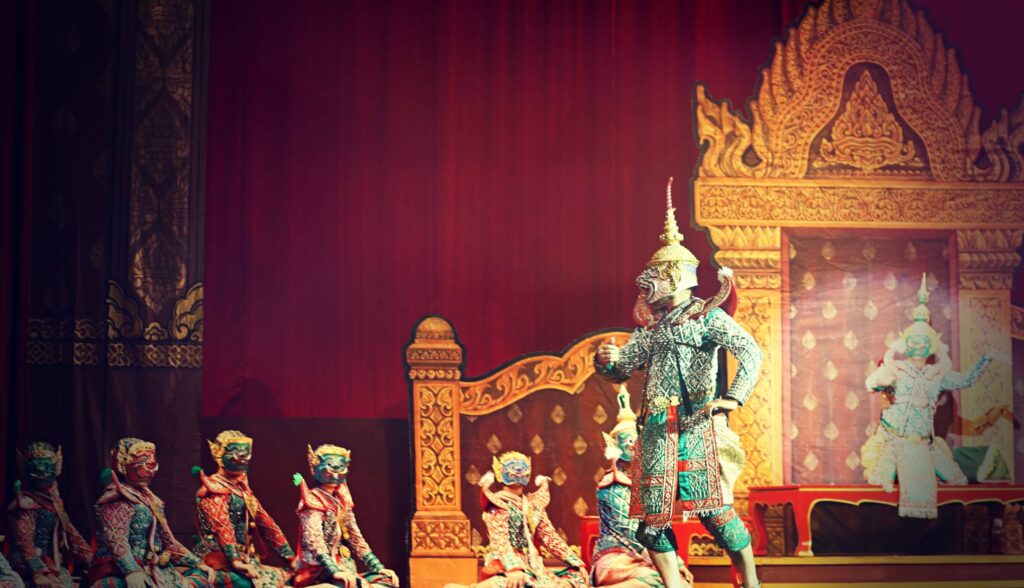
In contrast to heroes, demons wear masks of different colors. All masks have little fangs on almost grotesque faces. These characters are usually large, strong, and extremely devious. Demons cause all the trouble and give the heroes many headaches. Their dance is aggressive. Consequently, a demon moves with an open-leg position, which has its roots in martial arts.
One example, is an immoral and wicked demon king, Tosakanth. He has many typical styles of action. For example, when Tosakanth is angry, he stamps his foot furiously. Furthermore, he turns his face around to show that he is glad or wiggles his arms and legs when he is happy. Even when Tosakanth is shy, he has his own style of showing it.
The third group are the monkeys, who typically wear white masks. However, they are agreeable and are the generals and foot soldiers of the heroes and heroines. They are smaller and lighter in stature, agile, lively, and mischievous. While doing most of the dirty work involved in cleaning up the world, the monkeys act as clowns and acrobats. They are adept in the language of gesture. Their movements imitate those of real monkeys.
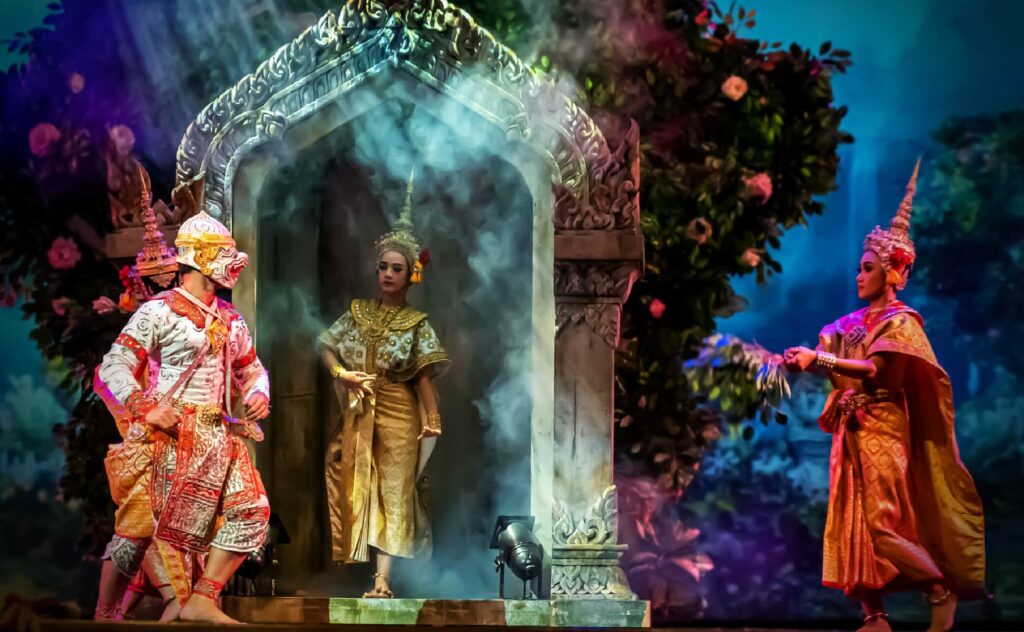
To become classical dancers, girls and boys practice movements for many years. Only a few girls will go on to play the major female roles. Others will become angels, forming a corps de ballet for the heroes. Nevertheless, the training is considered an asset to any Thai woman. The hand position is key to the female spirit, as is the whole posture and carriage of the body.
For the boys, things are rather different. While there are dominant male roles, there is also a great need for armies. The three groups of heroes, demons, and monkeys all have very different characters, both physically and emotionally, which the dancers have to represent. Heroes are well-proportioned and stately in bearing. Demons are athletic, while monkeys are short and acrobatic.
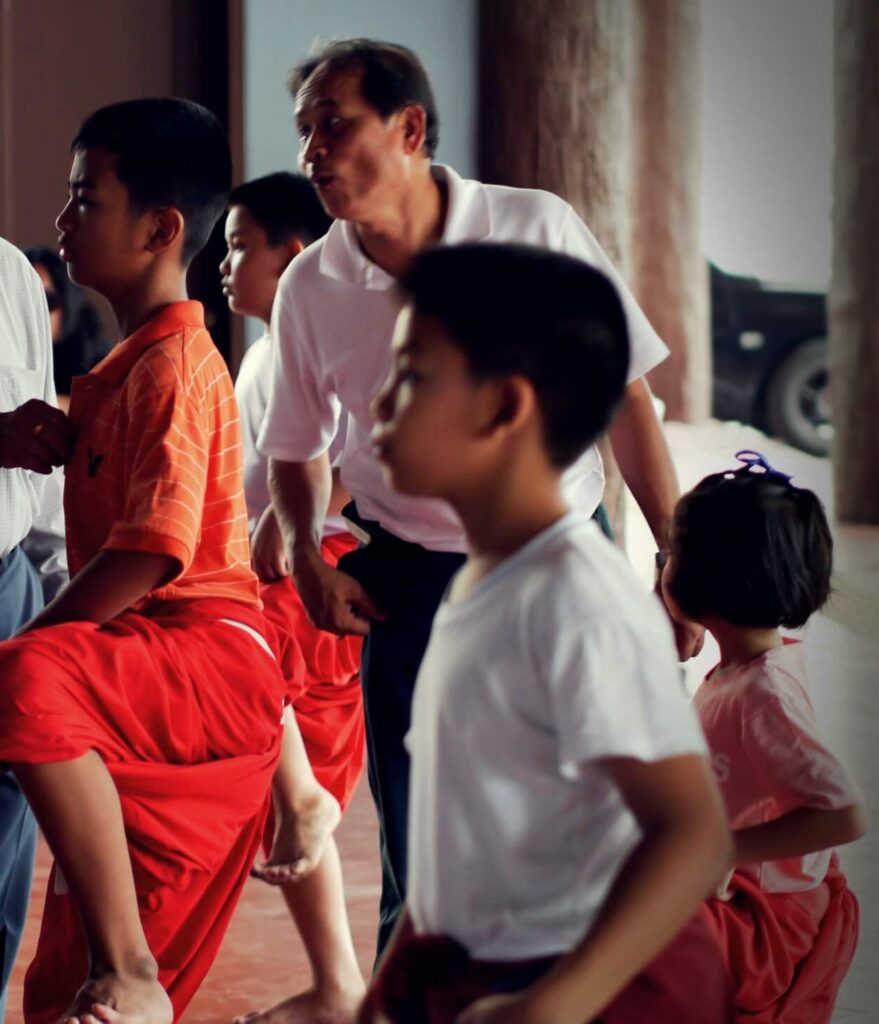
At a young age, a boy will be allocated to one of three groups based on his physical characteristics, and his potential as an interpreter of a role. As a result of this typecasting, he may remain in that role for life. However, in practice, there is some flexibility, as, throughout the years, boys can change a lot in physique and temperament.
As with all dance performers, there is a unity of style and motion. Now, there are sixty-eight movements of arms, fingers, wrists, legs and head positions, which all have an emotional meaning of some sort. Thai dancers usually hold their bodies straight from the neck to the hips in a vertical axis. Stretching to the rhythm of the music, they move their bodies up and down with their knees bent. However, performers keep their arms and hands in curves. The grace and beauty of the dancer depend on these curves and angles.
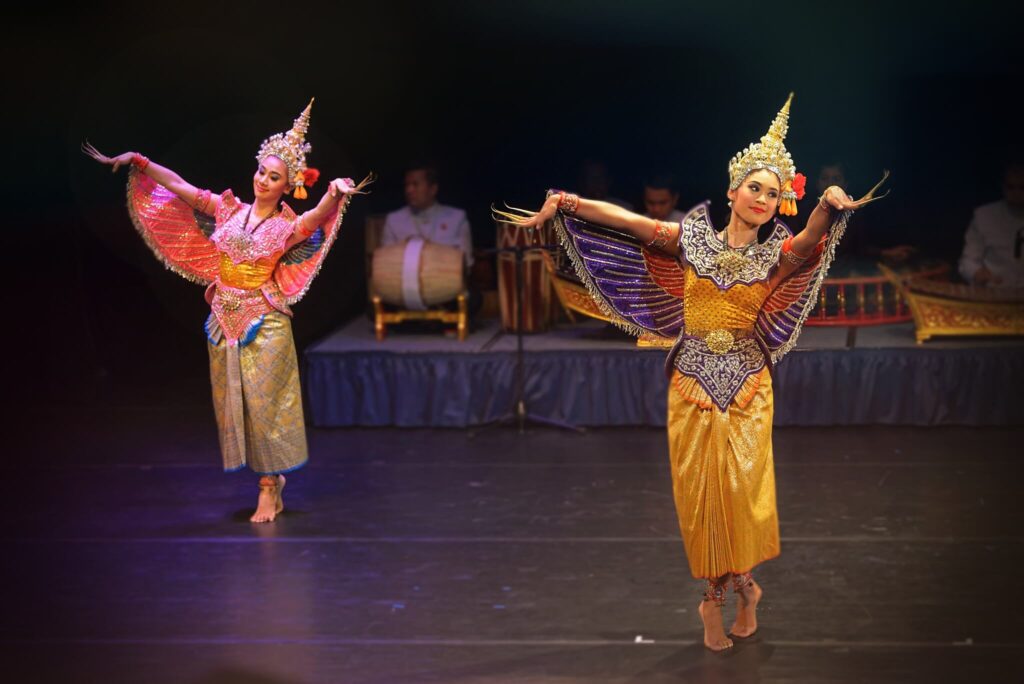
First, a dancer learns the basic slow and fast movements. The foot movements of Thai dance are generally slower than in India. The slow dance emphasizes the delicate movements of the arms and hands. In training, dancers bend their fingers backwards to create unnaturally elegant finger gestures.
In the next stage, performers refine the hand and arm gestures, which make up the complete language of emotional expression. They become a part of the personality of the dancer. After a while, they can string all of these gestures seamlessly together. The greatest dancers are those who can reflect the character they are playing and the emotions they are going through, with perfect ease and grace.
The wonderful costumes are one of the most stunning parts of Thai dance. They represent the past and seem to have no relevance to our world. Nevertheless, the dancers go the extra mile to get their costumes right. No performance of the Khon would be acceptable without these costumes. The Khon characters are elaborately dressed with each piece of ornament and headdress specifically named and assigned to a particular character.
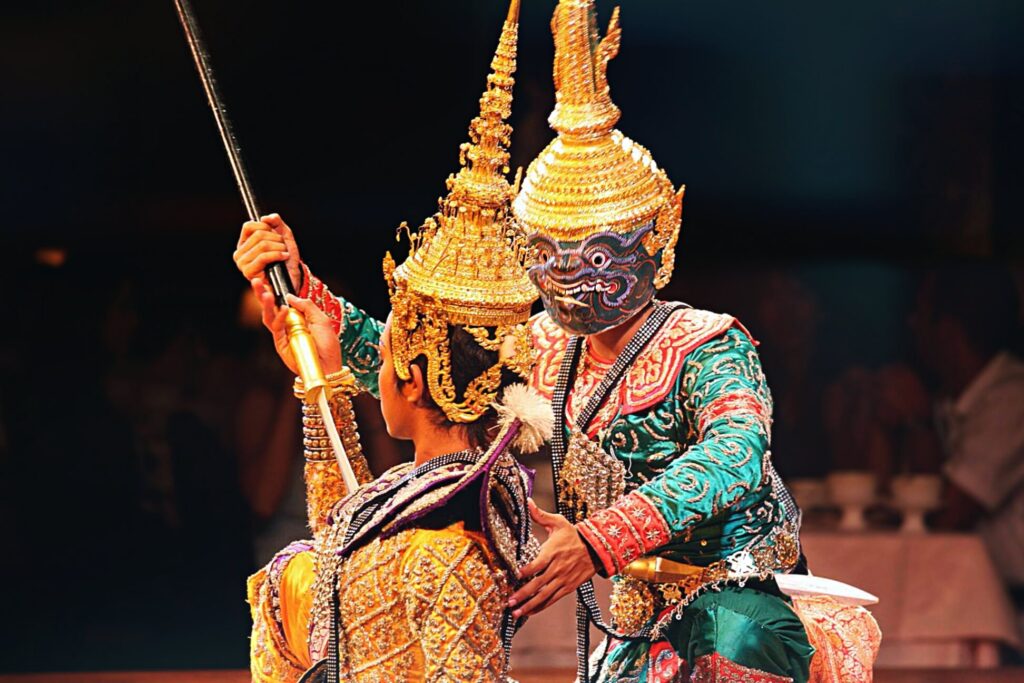
For example, a male dancer wears a long-sleeved brocaded shirt with glittering decorations and shoulder straps. Underneath the brocade, an actor wears an undergarment ending in a loincloth. Hanging in front of the brocade is chai wai, a decorative flap of cloth suspended from the belt, and chai krang, a scarf with the ends hanging down over both knees. A dancer can also wear a headdress, necklace, breastplate, embroidered girdle, bracelet, armlet, or anklet.
The weapons may also help to distinguish the characters of the Ramakien. For instance, Hanuman, the leader of the monkeys, carries a trident. The demon son of Tosakanth carries a bow and arrow. Furthermore, performers appearing very similar in masks and costumes are not usually on stage at the same time. This helps the audience to tell the characters apart.
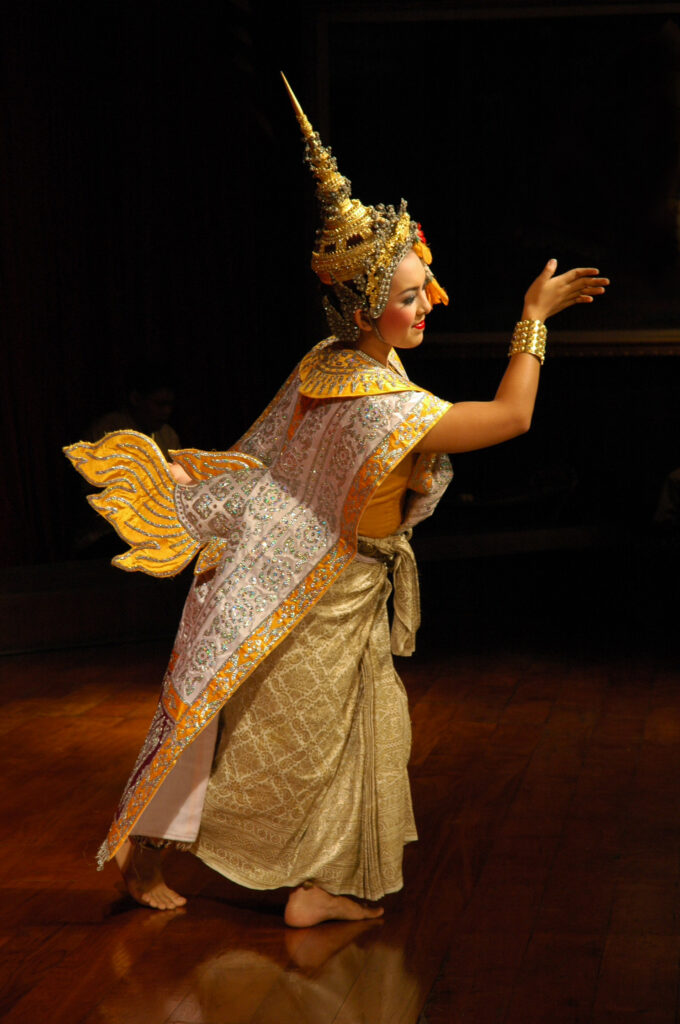
Whereas, a female dancer wears a short-sleeved shirt, before covering it with sabai, a shawl used to wrap over one shoulder around her chest and back. Then, she puts on a brocade folding in the front. Females also wear headdresses or tiaras according to their status. They can have jewelry, such as a diamond or chain worn from both shoulders across the breast.
In the story of the Ramakien, there are many extraordinary events in the struggle between Rama and the demon king Tosakanth. In one of the episodes, blinded by passion, Tosakanth ponders how to capture Sita. Benyakai, Tosakanth’s niece, offers to transform herself into Sita’s double and fool Rama and his brother. Upon agreement, Benyakai assumes her magical disguise as Sita.
She enters the water and floats up the Godavari River to a place where Rama bathes every morning. As he approaches the river, the apparently dead body of Sita floats upstream. Consequently, Rama is shocked at the sight of his dead beloved. After grieving, he turns to Hanuman, the general of the monkey army, who is not so easily taken in by tricks and appearances.
He wonders how a dead body could float upstream against the current, and he suggests that the body should be immediately cremated. They prepare the pyre and place the body upon it. Benyakai, unable to bear the heat, flies up into the sky. With his supernatural ability to fly, Hanuman pursues Benyakai. Finally, he catches her and falls in love with her.
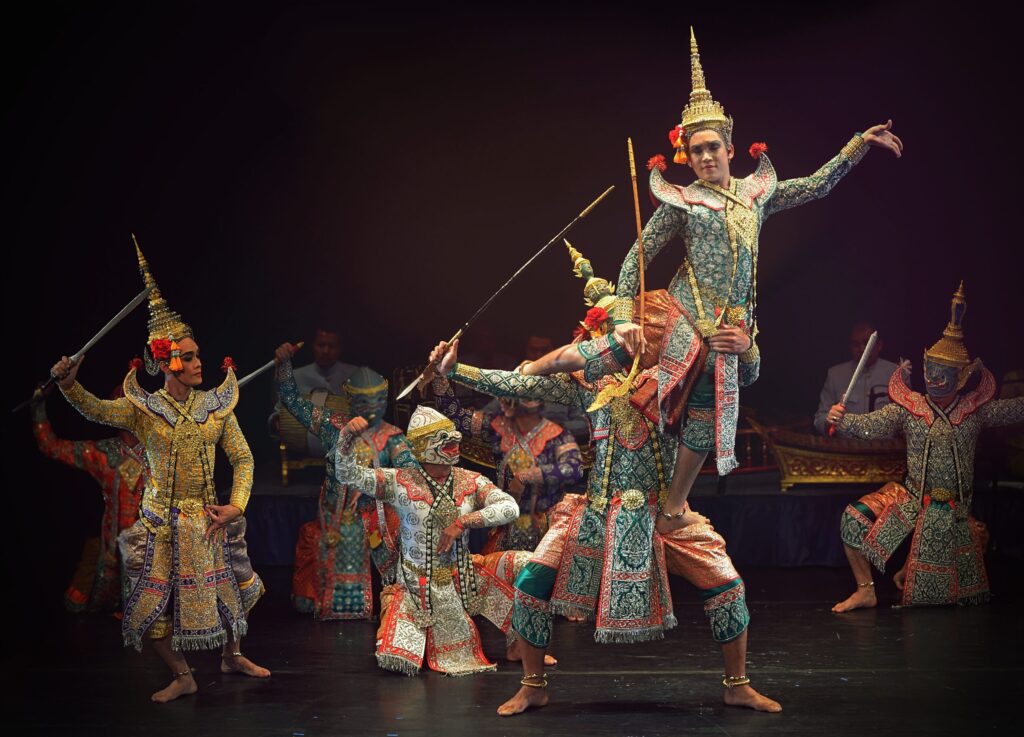
As the battle ebbs and flows, each time someone triumphs over someone else, they make a ritual mount on their opponent’s leg for a few seconds before resuming the fight. In the end, Rama and his brother, with the help of Hanuman, the monkey god, defeat the demons. Truth and honor win out, and the dance ends magnificently with Rama in the ascendant place.
Watch the Floating Lady episode or the full performance of the Thai classical Khon dance drama by the National Theatre of Bangkok in Thailand:
DailyArt Magazine needs your support. Every contribution, however big or small, is very valuable for our future. Thanks to it, we will be able to sustain and grow the Magazine. Thank you for your help!